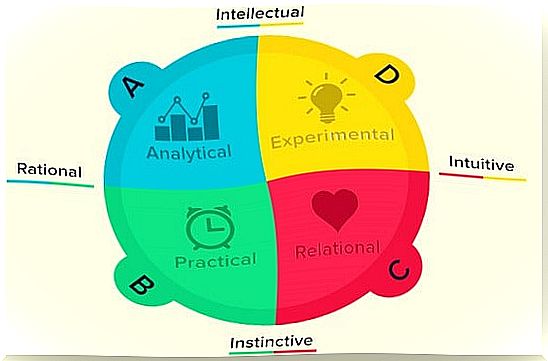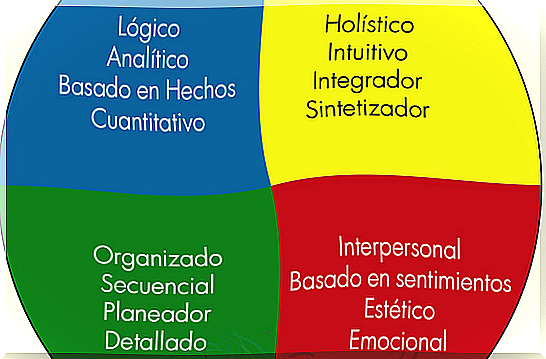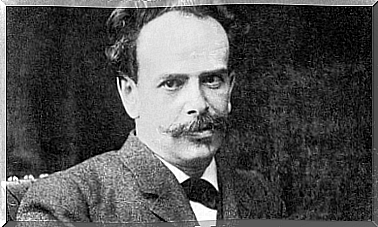Brain Dominance According To Herrmann’s Quadrants: Which One Is Yours?

The Herrmann Brain Dominance Test is a 120-question instrument used to find out how we process information and what your particular learning style is. Within this curious model, it is explained to us that the brain has four quadrants and that in general we all have a certain predisposition towards one of these types.
It is quite possible that more than one of our readers has ever performed this test. However, it must be said that it is not particularly common due to a very specific fact. The “Herrmann Brain Dominance Instrument” (HBDI) does not have validity from a neurological point of view, in fact, many scientists say that it is part of what is usually called “pop psychology”.
The topic of brain dominance and lateralization is highly controversial. Let’s take an example, in this instrument it is explained that creativity is located exclusively in the right hemisphere. It must be said that this data is not entirely correct, since the creative processes, in reality, make use of the entire brain, of each area in a neuroactivity as sophisticated as it is wonderful.
Does this mean that the Hermann brain dominance test is useless? Absolutely. There is an aspect that makes it valuable, and therefore, it is advisable to bring it up in our space. This test starts from an important premise: each person has a particular way of processing information, transforming it, inducing data, and interpreting.
We only have to see it in the students when studying or even in ourselves when we work. There are those who are more meticulous, conservative, others are innovative, some are more visual and others process information better in an auditory or communicative way … All of this fits with the hypotheses that are handled in the Herrmann test and that is the classification that can offer us .

Brain dominance in the Herrmann test
Before talking about this instrument developed in the 90s, it is worth talking about its creator, Professor Ned Herrmann. He was president of the American Association for Creativity and one of the pioneers in creative thinking and reasoning. Specializing in physics and music, he worked from a very early age at General Electric with one goal: to improve production, motivation and creativity of employees.
To do this, Mr. Herrmann analyzed the different thinking and learning styles of all workers, thereby inducing a brain map. From there, he developed the theory of the brain quadrants to enunciate 4 typologies, four different ways in which people, supposedly, we tend to learn, think, create, interact and understand our reality.
This brain dominance is described as follows:
Type A: analytical people
Ned Herrmann called them experts. It is a type of profile characterized by a logical, analytical and rather technical style of thinking.
- They are very rational people who infer data from concrete facts.
- Likewise, analytical people tend to be rather competitive and individualistic, also intelligent, ironic and with a great sense of humor.
- The jobs most closely related to this type of brain dominance are those related to mathematics, physics, engineering, chemistry …

Type B: the organizational style
As the word itself explains, we are facing a type of organized profile, lover of order and meticulousness.
- They do not carry out any action without having planned it in advance, they like everything that is predictable, conservative and that is also under their control.
- Generally, in this “organizational” quadrant there can be company directors, managers, accountants …
Type C: the relational
Type C refers to that brain dominance that tends to be emotional, to the need to connect with others, to relate to enjoy that social contact where you can feel useful, where you can give and receive.
They are people who know how to communicate, who are spontaneous, outgoing and who generally tend to prefer jobs such as journalism, nursing, social work, law, etc.
Type D: the experimental
The fourth profile of this test on brain dominance refers to that personality characterized by a holistic mentality. They are visual profiles, spontaneous and highly creative.
They are people who like to experiment and innovate, even if it has some associated risk. They always look to tomorrow but try to learn from the present in order to go further every day.
Thus, the professions that usually encompass type D are architects, writers, musicians, painters, designers, etc.

To conclude, after having seen these four typologies of the Herrmann brain dominance test, it is possible that more than one is not identified with a single area. It is habitual. In fact, estimates on the Herrmann Brain Dominance Instrument (HBDI) tell us that nearly 60% of the population typically have traits in more than one of these four areas.
Also, it is important to note that no dominance is better than another and that they do not determine or predict anything. It only tells us what orientation we usually have when interacting with our environment or our style to process the data that comes to us from it. It is, why not, a simple way to get to know each other a little better.









